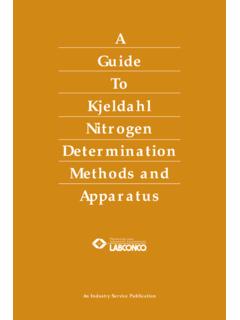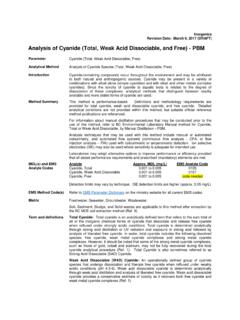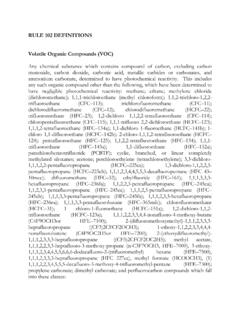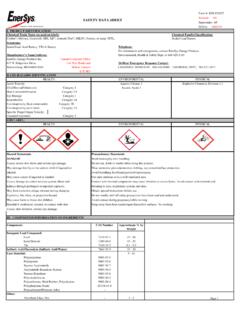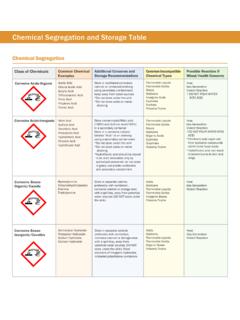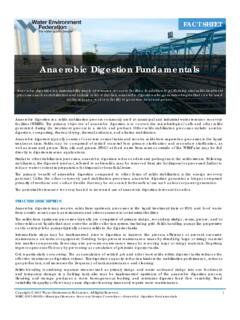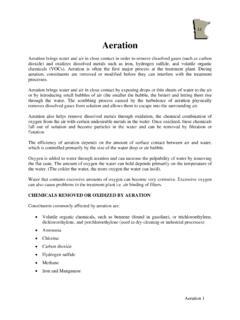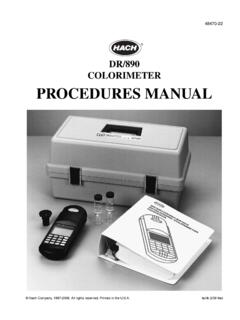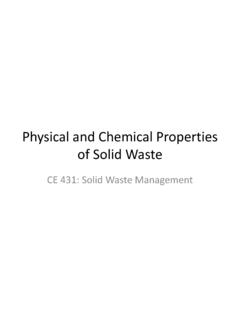Transcription of A Guide To Kjeldahl Nitrogen Determination Methods and ...
1 AGuideToKjeldahlNitrogenDeterminationMet hods andApparatusAn Industry Service Publication ForwardThis booklet has been developed to serve as a technicalcompanion in the selection and use of Kjeldahl nitrogendetermination Methods and apparatus. This material hasbeen prepared with the help of Kjeldahl chemists, consul-tants and Labconco will not teach you to performthe Kjeldahl procedure but will help you understand steps inthe process. This generic presentation is designed to helpeducate persons unfamiliar with Kjeldahl methodology andanswer frequently asked questions raised by Kjeldahl Determination has a long history in the area ofanalytical chemistry.
2 Johan Kjeldahl first introduced theKjeldahl Nitrogen method in 1883 at a meeting of the DanishChemical Society. As chairman of the chemistry departmentof the Carlsberg Laboratorium near Copenhagen, Kjeldahlwas assigned to scientifically observe the processes involvedin beer making. While studying proteins during malt produc-tion, he developed a method of determining Nitrogen contentthat was faster and more accurate than any method availableat the time. His method used simple equipment and could beperformed by an inexperienced 1883, the Kjeldahl method has gained wideacceptance and is now used for a variety of Nitrogen determinations are performed on food andbeverages, meat, feed, grain, waste water, soil and manyother samples.
3 The method has been refined and tested for awide variety of substances and approved by various scientificassociations including:AOAC International (formerly the Association of OfficialAnalytical Chemists)Association of American Cereal ChemistsAmerican Oil Chemists SocietyEnvironmental Protection AgencyInternational Standards OrganizationUnited States Department of AgricultureWhat is the Kjeldahl method?The Kjeldahl method is a means of determining thenitrogen content of organic and inorganic the technique and apparatus have been alteredconsiderably over the past 100 years, the basic principlesintroduced by Johan Kjeldahl endure Kjeldahl method may be broken down into threemain steps:Digestion-the decomposition of Nitrogen in organicsamples utilizing a concentrated acid solution.
4 This isaccomplished by boiling a homogeneous sample in concentrated sulfuric acid . The end result is an ammonium sulfate adding excess base to the acid digestionmixture to convert NH4+to NH3, followed by boiling and condensationof the NH3gas in a receiving to quantify the amount of ammonia in thereceiving amount of Nitrogen in a sample can be calculatedfrom the quantified amount of ammonia ions in the Digestion ProcessA general equation for the digestionof an organic sample is shown below asone basic example:Organic N + H2SO4 (NH4)2SO4+ H2O + CO2+ other sample matrix by-productsA number of interrelated digestion conditions determinethe rate of reaction and the completeness of the breakdownof Nitrogen to ammonium sulfate.
5 Among these are heatinput to the acid digestion mixture, amount of inorganic saltadded to elevate the acid boiling temperature, reflux rate ofH2SO4in the neck of the digestion flask, length of digestion,and catalyst addition. Adjusting any one of these factors hasan influence on the others. Proper digestion conditions for agiven sample matrix are achieved through establishing a bal-ance of these factors in a controlled and repeatable addition, if the sample contains nitrate or nitrite Nitrogen ,it is possible to chemically pretreat the digest to include orexclude this Nitrogen source from the analysis as desired in aparticular ConsiderationsSulfuric acid has been used alone for the digestion oforganic samples.
6 (As a convenience to reduce bumping ofthe digestion mixture, Alundum boiling chips or pumice areoften added.) The amount of acid required is influenced bysample size and relative amount of carbon and hydrogen inthe sample, as well as amount of Nitrogen . A very fatty sampleconsumes more acid . Also, heat input and digestion lengthinfluences the amount of acid loss due to vaporization duringthe digestion process. Remember that a Kjeldahl flask isessentially a bulb with a condenser neck off to the side forrefluxing of the Input and Digestion LengthTypically the heating elements used for Kjeldahl diges-tions have variable settings.
7 Heat input is frequently specifiedas that setting which brings 250 ml of water at 25 C to arolling boil in 5 minutes. Initially an organic sample usually chars and reaction may at first be very vigorous depending on thematrix and the heat input. With organic decomposition thedigestion mixture gradually clears as CO2evolves. Metallicions might tint the clear digestion mixture. Note that solutionclearing in itself is not an indication that all organic nitrogenhas been broken down. Digestion length must be determinedby recovery studies on known materials of similar matrix if anew method is being Salicylic acid followed by sodium thiosulfate hasbeen used to pretreat the mixture to ensure complete reduc-tion.
8 Other reduction schemes have been devised. Or otherpretreatments have been used to prevent nitrates from beingreduced at all during the charring process, leaving a cleardigest with no contribution from nitrate DistillationProcessThe acid digestion mixture is dilutedand made strongly alkaline with NaOH,liberating NH3as follows:Salt AdditionsThe problem with using sulfuric acid alone for diges-tion is very long digestion times result with many samplesdue to the slow rate of organic decomposition. The additionof an inorganic salt to the digest elevates the boiling point ofthe H2SO4. The solution temperature of concentrated sulfuricacid alone is about 330 C.
9 Addition of a salt such as K2SO4can elevate the solution temperature of the digestion mixtureto 390 C or more, depending on the ratio of salt to significantly increases the rate of organic decompositionin the digestion mixture, shortening the length of timerequired for are several precautions to keep in mind con-cerning salt addition. First, it is possible to raise the solutiontemperature of the digestion mixture too much. If the tem-perature goes much above 400 C during any phase of thedigestion, volatile Nitrogen compounds may be lost to that as acid is gradually consumed duringthe digestion process, for the various reasons mentionedabove, the salt acid ratio of the digest gradually rises.
10 Thismeans that the hottest solution temperatures are attained atthe end of the digestion. Heat input, consumption of acid byorganic material and vaporization, salt/ acid ratio, digestionlength, and physical design of the Kjeldahl flask, are all interre-lated. Each has an effect on the final solution second precaution is that if the salt/ acid ratio is toohigh, a considerable amount of material will salt out uponcooling of the digest. Concentrated acid pockets can be con-tained within the cake. These can react violently when con-centrated base is added in the distillation process. A certainamount of salting out can be managed by diluting the digestwith water while it is still somewhat warm, but not too AdditionsSeveral catalysts have been employed by Kjeldahlchemists over the years to increase the rate of organic break-down during the acid digestion.


